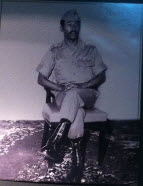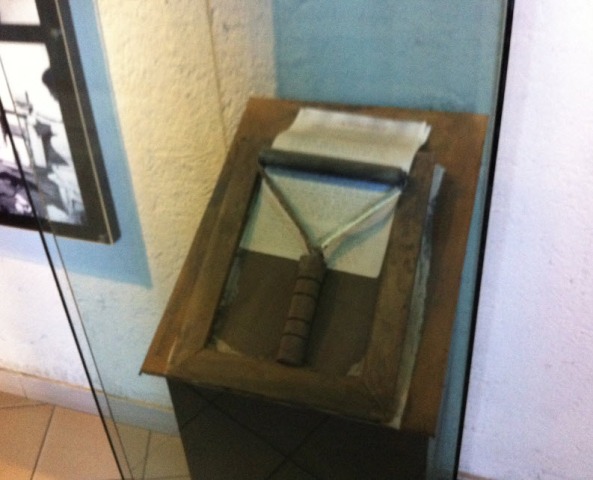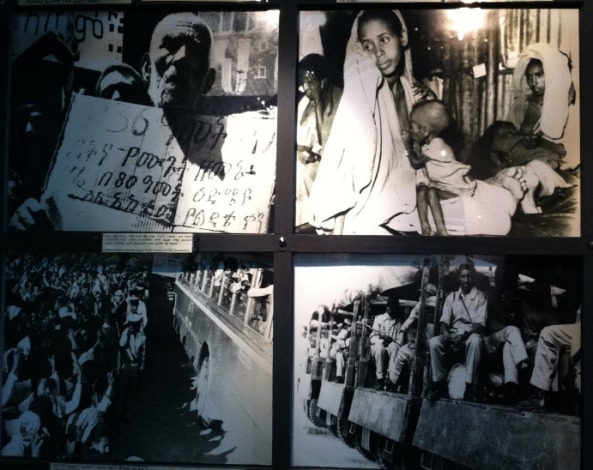Yesterday I visited the Red Terror Museum. The Museum opened last year (2010) in March and on display there are many artefacts (some very gruesome) from the Communist time in Ethiopia which lasted from 1974-1991. The museum is very well presented and it is more modern than other museums in Addis. Tour guides explain the exhibits to you and this is how I learnt so much about the Derg occupation. Their English is very good, so you can ask questions and they will answer. They also give first-hand accounts and a lot of information that is missing from the exhibits. Some of the information doesn’t quite match with what is on the internet, but most of it is more or less the same and it is in a lot more detail than what you can find on Wikipedia or in history books. I was interested to come here; if I’m going to be an Ethiopia resident for the next two years, I want to know as much of the country’s history as possible.
Right before the occupation of the Derg, the people of Ethiopia were dissatisfied with Haile Selassie and the way he was ruling the country. During the famine in the late 1960s to early 1970s, people of Ethiopia were suffering while Selasie continued to live his luxurious and lavish life. The famine was crippling the country, especially in the North and north eastern parts of the country; Haile Selassie refused to acknowledge or address this. People were walking from miles away to come to Addis to beg on the streets for food. Not like the beggars today – these people were totally skeletal and close to death. You may have heard of “The Hidden Hunger” or “The Unknown Famine” documentary by British Journalist Jonathan Dimbley. This documentary was a sobering and graphic portrayal of the desperate situation and enraged the public when it was aired on TV in 1973. It eventually contributed to the overthrowing of Hailie Selassie in 1974.
Times were tough and it is maintained that Selassie refused to acknowledge this. Contrast was one of the main themes presented at the Red Terror Museum: pictures of desperately skeletal famished people versus Pictures of Haile Selassie with his lavish cake which he had brought in from London for his 80th Birthday. These two images representing desperate vs luxury were prominent on placards when protests took place in Addis.
Top second from left: picture from Dimbley’s documentary “the Hidden Huger”. Top third from left, protesters holding signs with a picture of Selassie and his birthday cake from London, next to starving citizens
Before all of this, in 1960, two brothers, Birgadier General Mengistu Neway and Giramame Neway, with the help of two others, staged the coup d’etats when Selassie was away in Brazil. According to information at the Red Terror Museum, they managed to kill most of Selassie’s officials, take control of Addis Ababa and proclaim that the reign of Selassie was over. A new government under Asfaw Wossen – Selassie’s son – was proclaimed. But this didn’t last, and in an agreement between Birgadier and Giramame, they had decided that if it would fail, they would not continue to serve under Selassie’s reign. To this end Giramame shot Birgadier in the eye before turning the gun on himself. However, Birgadier wasn’t killed. He was captured, treated then sentenced to death. He was hanged in 1961 in Teklehamimot Square in Addis Ababa, near the Mercato market. This movement was considered to the one that was of the most threat to Selassie, until the Derg movement in 1974. At the Red Terror Museum in Addis, there is a sign on the wall with the translation of the speech he made before he was hanged.
Other movements included student movements. Walelyne Mekonnen and Mark Mebratu, prominent student leaders attempted to hijack an Ethiopian Airlines flight, but anti hijackers killed them before they managed to do it. Another student movement leader and president of the USUAA (University Students Union of Addis Ababa), Tilahun Gizawwas, was killed by the imperial secret service in December 1969. He was leaving the university with his girlfriend when he was shot dead.
On 24 Feb 1974, Prime Minister Aklilu Habtewold’s rule came to an end and a new PM came to power on 1 March 1974: Endalkachew Mekonnen. This brought about the popular slogan “Gulicha bilewawet wot ayataftia” – “a monkey in silk is a monkey no less”.
A further series of events contributed to the downfall of Selassie:
– The trade union staged a three day strike, demanding democracy.
– The Muslims staged a protest on 26 April, 1974, demanding that their holidays be recognised.
– Author Abbe Gubegna was found dead in his hotel room. He wrote books criticising the Imperial Government System; it is thought they were the ones who killed him.
– 120 men from various military forces (air forces, ground forces etc) formed a committee, the “Derg”. (“Derg” in Amharic means committee). These men imprisoned and later killed Selassie’s highest officials, and eventually came into power.
On September 11, 1974 Selassie was taken from his home and driven in his driver’s car, a cream VW Beetle to the house where he was imprisoned until his death, two years later. Officials did not want to take him in his Mercedes car, because they did not want to draw attention. The cream VW Beetle is still around, it has been restored and now is in the possession of the driver’s wife. The Red Terror Museum is trying to get it to put on display as an artefact in the museum.
Following the downfall of Selassie, the people of Ethiopia began to experience the aggression and violence of the new harsh Derg movement. Although with the famine things had been dire, at least there had been justice when Selassie reigned, and they yearned for his return.
After three months in power, Mengistu ordered the death of 83 higher officials of Hailie Selassie, by vote, without trialling them. Among these men there were two former Prime Minsters. For a long period of time, it was thought that only 60 men were killed. Eventually one of the killers wrote a confession letter, explaining how it happened and who was killed. The killer was one of two, and they were told to kill whoever was brought into the room. They had machine guns and as men were sent in, in twos and threes, they would shoot them and remove their artefacts: necklaces, silver crosses, rings etc. They counted eighty three. After all of the men had been killed and their bodies lay on the floor, the two killers realised that they too were going to be killed, in an attempt to silence what had happened. So they decided to make a run for it. They took their machine guns and began firing at everyone outside the room. They ran for the entrance of the compound. One killer was shot, but the other managed to make it to the gate and escape. He fled to Sudan where he later wrote the letter of confession. Years later, he was living in London, and in a church he approached the son of one of the men he had shot. He said to the son that he had a confession. The son said that he thought he was a crazy man, and told him that he was not a priest. The man responded that the confession was for him, not a priest. Although he thought he was crazy, he wanted to show the man kindness so he listened to what he had to say. The son was a well-known journalist and this was how the killer had recognised him. He said to the son “I killed your father”. The son thought he was mad, until he pulled out the necklace of his father, with his name and date of birth engraved into it. He listened to the confession of the killer, who had blood cancer and wanted to confess what he had done before he died. After confessing to the son, he died one and a half months later. The son buried him and held a memorial for him.
The letter ordering the death of 80 of Selassie’s highest officials
Mengistu ordered these men, Selassie’s highest officials, to be killed, without legal procession, by vote.
This man’s son, a well-known journalist living in London was approached by one of the killers, who confessed to what he had done
Throughout the reign of the Derg, there were many peaceful protests, however, the Derg responded to them with bullets. In 1976, in one such demonstration, at least 1400 young people were killed in the streets in Addis Ababa, in one day.
Initially the leader of the Derg was Tafari Banti. However, in 1977, second in charge Mengistu Haile Mariam killed him and the third in charge, making himself President of the People’s Democratic Republic of Ethiopia. It is also rumoured that Mengistu killed Haile Selassie by smothering him with a pillow.
Mengistu, second in charge on the left, Tafari, the president, in the middle and the third in charge on the right
Mengistu – the short one in the middle Mengistu – he was only young, about 30-40yrs old, according to my driver
Mengistu – he was only young, about 30-40yrs old, according to my driver
Following the death of Haile Selassie, which occurred on September 11, Mengistu enforced military demonstrations every year on the same date in Meskel Square, the centre of Addis Ababa. These military demonstrations were held to show the military’s strength to the public. The force was considered to be the largest military force in Africa. Crowds of people would stand in the Meskel Square to observe. They had their homes stormed and were forcefully made to attend these military parades by the Derg.
Mengistu’s “wanted” list comprised of 755 people. Names and pictures of the people were released and members of the Derg were given free-rein to torture and kill these people. Among them was a nine year old boy. When asked why he was killed, his killer denounced that it was because he was anti-Derg.
The Wanted Lists:
Innocent citizens were armed by the Derg and ordered to torture and kill without the procession of law. Various gruesome implements on display in the museum included apparatuses used to pull out the teeth, toe and finger nails of people, whips, chains and rope used to strangle. Shackles and handcuffs were also used.

Citizens were armed by the Derg and ordered to kill
Some people fought back against the Derg, but they had to do so discretely; if they were found out they and their families would be tortured and killed. One duplicating machine used to print and duplicate anti Derg leaflets was buried and dug up 33 years later at the compound of Holeta Agricultural Centre, on the outskirts of Addis. It was presented to the museum at its inauguration in March 2010.
Duplicating and printing machine, buried for 33 years
Anti-Derg leaflets were secretly printed and distributed
Adefres – a home-made duplicating machine used to duplicate underground anti-Derg leaflets
Men were ordered to kill people suspicious of anti-Derg views. The anti-Derg leaflets were “proof” that people were anti-Derg
Door to door searches to hunt down and kill opposition members were frequent. People would be brutally killed on suspicion.
According to Amnesty International’s Report, more than half a million youngsters (men and women), elders, Christians and Muslims were indiscriminately killed by the Derg. 54,000 of these were young people. Mostly these victims were educated people, because the Derg saw them as a threat to their regime.
One man, Kebede Worku was shot in 1978 in Addis Ababa, in front of Hagar Firr Theatre. Miraculously he survived and when he came to consciousness, he crawled away, out of the other dead bodies. Some people found him and secretly helped him. But he was captured and imprisoned for seven and a half years without the procession of law. His shirt, which has two bullet holes in it – in the chest – was hidden for 32 years by his mother. In December 2010, she presented it, along with one of the bullets that was removed from Worku, to the museum.
During the Derg, Addis was divides up into 25 locations and 292 sublocations. It is said that 95% of these locations were torturing places and prisons. One prison was named Bermuda prison, after the Bermuda triangle. People would go and would never be seen again. Most of these sites have now been demolished.
Derg times
In one of the rooms at the Museum there is a recreation of a mass grave. The guide informed me that people were taken to the outskirts of Addis and lined up and shot dead. The killing always happened at night, after midnight, usually between the hours of 2 and 4am. After they were killed, they were hauled into a massive hole that had already been dug during that day. When the killers would leave, hyenas and wolves would emerge, dig up the graves and feast of the corpses. In the room there are bones and skeletons of victims that were dug up after the fall of the Derg. Real skulls are in glass cabinets, hundreds of them, along with leg and arm bones and who knows what else. It is incredibly gruesome. I couldn’t get out of there fast enough. Also on display are the shoes of many of the victims, also dug up after the fall of the Derg. They are crammed into a coffin-shaped box. The coffin lies on the floor and covering it is a sheet of glass which doesn’t quite fit the top of the coffin. The guide pointed out a bone which was still inside one of the shoes, it had been snapped off at the ankle. The horrible thing was that it you moved the glass by sliding it across, you would be able to touch the shoes and the bones. I think I’m pretty squeamish. I always thought I was brave, but seeing this made me want to get the hell out of there. It was absolutely awful. There was some stupid chatty woman there from the Philippines – she was merrily and cheerfully asking the guide if she was allowed to take pictures. I felt like smacking her. I couldn’t bring myself to take pictures of dead people, it didn’t seem right. But if you really want, you can search Google images “Red Terror Museum” you can see pictures of the bones and skulls. Only eleven bodies/skeletons were ever identified. I asked the guide about this and he said that DNA testing was just too expensive. You need money, and people here don’t have the money to do that. It’s incredibly sad. So as a result, hundreds of skulls are piled into a glass case together. They aren’t even with their leg bones – all the leg bones are piled into another cabinet…it’s pretty heartbreaking.
Eventually the military was driven out in 1991 by anti-Derg fighters and with some help from the west – the US, the UK…There is a map of Ethiopia showing where the anti-Derg groups were located. Estimates state that there were about a hundred thousand anti-Derg fighters, but these estimates are incredibly conservative. It is thought that just two groups in the North alone had more than those numbers. No one will ever know because no one wants to come forward. Also, people at the time never admitted to it for fear of being murdered.
Members of the Derg were captured and imprisoned, however, at the last hour, the President, Mengistu, fled to Zimbabwe. The guide told me that Mugabe refused to release him back to Ethiopia because the two were friends: Mengistu had helped Mugabe come to power and he had also trained Mugabe’s troops and soldiers in Ethiopia. According to the guide, today he lives on a luxurious ranch in Zimbabwe, where he plays tennis every day. His children went to university and are doctors.
The EPRDF, The Ethiopian Peoples’ Revolutionary Democratic Front, the party that took over the Derg Party, is still in power today: the same men, the same people, the same party, the same faces. After they came into power in 1991, peace followed. But after this, people began asking questions and demanding justice. Families of victims who were not allowed to grieve at the time were finally allowed to mourn and there were mass outpours.
According to the guide, the members of the Derg were sentenced to life imprisonment. They were tried, because it was a democracy. They were given lawyers and rights. This upset the people of Ethiopia who said that they had not been shown this democratic fairness. After being sentenced to life imprisonment, the men appealed to the Supreme Court. The Supreme Court issued them with a harsher punishment: they sentenced them to death. This was appealed to the highest court in Ethiopia (I didn’t know there was one above the Supreme Court, but hey, I didn’t study law) who reduced it back to life imprisonment. The men served twenty years and were recently released – I think the guide said they were released a month ago. They now live overseas.
The statue outside the museum says “Never, ever again”. It is a reminder of the horrible times of the Derg. Ethiopians call it “their holocaust”. It was erected by an Ethiopian woman at the opening of the museum. Her four children were killed in one night at the hands of the Derg.















